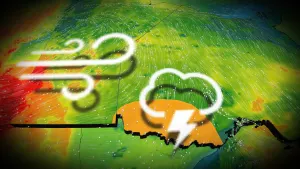
Ships are illegally dumping plastic trash at sea, study suggests
Thousands of plastic drink bottles are washing up on a remote, uninhabited island in the South Atlantic, and researchers say they're evidence of illegal dumping from cargo ships.
Ships have been strictly banned from throwing trash overboard for more than 30 years.
Nevertheless, "ships are responsible for most of the bottles floating in the central South Atlantic Ocean, in contravention of International Convention for the Prevention of Pollution from Ships regulations," concludes the new international study published recently in Proceedings of the National Academy of Sciences.
"It's a surprise in that it makes us rethink the source of the garbage in our oceans," said Robert Ronconi, a Halifax-based researcher, currently with the Canadian Wildlife Service, who co-authored the new study. "One of the common assumptions is that most of the garbage in the oceans is flowing out of rivers on land."

Kayakers take in the last of the day's light as they paddle past a ship anchored off Cape Town. A new study suggests garbage dumped off ships is the source of plastic trash washing up on a remote, uninhabited island in the South Atlantic. (Mike Hutchings/Reuters)
A commonly cited estimate is that 80 per cent of plastic in the oceans is washed into the seas from land-based sources, and much of the rest is fishing gear.
Ronconi was part of a team led by Prof. Peter Ryan, director of the Fitzpatrick Institute of African Ornithology at the University of Cape Town, that tracked and examined trash washing up on Inaccessible Island from over more than three decades. The island is close to halfway between South Africa and South America.
SEE ALSO: Did you know? Cigarette butts contaminate our water supply
In 2018, the team collected 2,580 plastic bottles from about a kilometre of beach, plus another 174 that washed up over 10 weeks. They found that 73 per cent of accumulated bottles and 83 per cent of newly arrived bottles had been manufactured in China and had date stamps indicating they had been manufactured in the past two years — not enough time for them to travel from Asia without the help of ships.

Maelle Connan, a member of the research team, checks bottles washed ashore on Inaccessible Island for manufacturers' marks to determine when and where they were made. Most were manufactured in the previous two years. (Submitted by Peter G. Ryan)
Ronconi and Ryan are seabird researchers who visit the island primarily to study the millions of seabirds that live and nest along the tall cliffs that wrap around it on all sides. Some of them breed nowhere else in the world — including the great shearwater, which Ronconi was studying during his postdoctoral research at Dalhousie University.
"Without hesitation, it's the most fantastic place I've ever been in my life," said Ronconi.
Researchers land at one of the only flat spots at the edge of the island — a beach of pebbles and boulders scattered by crashing waves. Behind them washed-up logs are jammed up among tall grasses. And scattered about it all flash yellow, orange, blue and red fishing buoys, floats, trays, bottles and other garbage.
"They do stick out," Ronconi recalled.
GROWING AMOUNT OF GARBAGE
Ryan noticed the litter on his first visit to the island as a master's student in 1984. It took him about three hours to scoop it all off a kilometre of beach.
But the amount has grown dramatically since then.
In 2018, several researchers collected everything from the same stretch of beach, and it took them two days.
"What was really striking was just how bottles had come to dominate," said Ryan.
In 1984, they were a tiny fraction of the trash on the island, and most appeared to have drifted on the currents from South America.
In 2018, they made up one-third of the litter that had accumulated on the beach, and three-quarters of what arrived during the 10 weeks the researchers were there.

Inaccessible Island is a remote island in the South Atlantic between South Africa and South America. Millions of birds nest in the cliffs that wrap around it. (Submitted by Peter G. Ryan)
While the researchers initially wondered whether they might have come from fishing fleets, their Chinese origin made that unlikely, since there isn't much Chinese fishing in the area, and fishing overall has declined slightly in that part of the ocean.
However, the growth in bottles coincided with an increase in shipping traffic between Asia and South America, leading the researchers to conclude the bottles had been thrown off cargo ships plying that route.
Martin Thiel is a professor at Universidad Católica del Norte in Chile who was not involved in the study, but researches the composition and abundance of marine litter. Thiel said the growth in plastic bottles in particular was notable. But he cautioned against blaming ships from any particular country, since they would all be likely to buy bottled water in China when making stops there.
"The finding of these bottles does not indicate that the Chinese are the guilty ones — it could just as well be European or North American ships coming from China," he wrote in an email.

This image shows how Master Kong 500-millilitre water bottles, the most abundant bottle on Inaccessible Island, age over approximately three years. (Submitted by Peter G. Ryan)
Unfortunately, this isn't the only study suggesting that littering at sea is contributing to the plastic pollution problem.
Ryan said he's been involved in surveys in South Africa, Kenya and Australia that all found similar results. Debris from passing ships was found in the the Paranagua Estuarine Complex in Brazil in 2013 and a study in the early 1990s found 75 per cent of observed fishing vessels along Canada's east coast threw debris into the sea.
POSSIBLE SOLUTIONS
The International Maritime Organization says it has adopted an action plan on marine litter to get more data about marine plastic litter from ships, enhance regulations, and introduce new measures to tackle the problem.
The International Chamber of Shipping has acknowledged that one problem is that the quality of waste facilities at ports is highly variable.
"Indeed, some developed countries actually provide poorer facilities than their developing nation counterparts, or offer services based on varying tariff structures which often do not encourage their use," says a statement released by the group this year.

This newly arrived water bottle has been colonized by goose barnacles. (Submitted by Peter G. Ryan)
In response to the study, Stuart Neil, the group's communications director, said the industry takes this issue "very seriously."
He said illegal dumping of garbage may result in criminal convictions and heavy fines.
However, a previous study of this problem noted that enforcement is a challenge because it's hard to detect violations at sea and often impossible to link debris with a particular ship.
Ryan suggests the shipping industry needs to be more proactive about enforcement of regulations by conducting waste audits of ships when they return to land.
He added that the right incentives can also help. He gave the example of a South African trawl fleet where managers used to reward skippers for having a clean ship. "That just promoted people sweeping everything over the side," he said.
When a friend of his became the company's operations manager, he decided instead to reward skippers based on the amount of litter they returned to port. "And all of sudden they were bringing back bags of rubbish. It's just little things that can really change behaviour."
He added that since the study was published, two shipping companies have contacted him saying they want to work to solve this problem.
This article was originally published by CBC News and written by Emily Chung.









